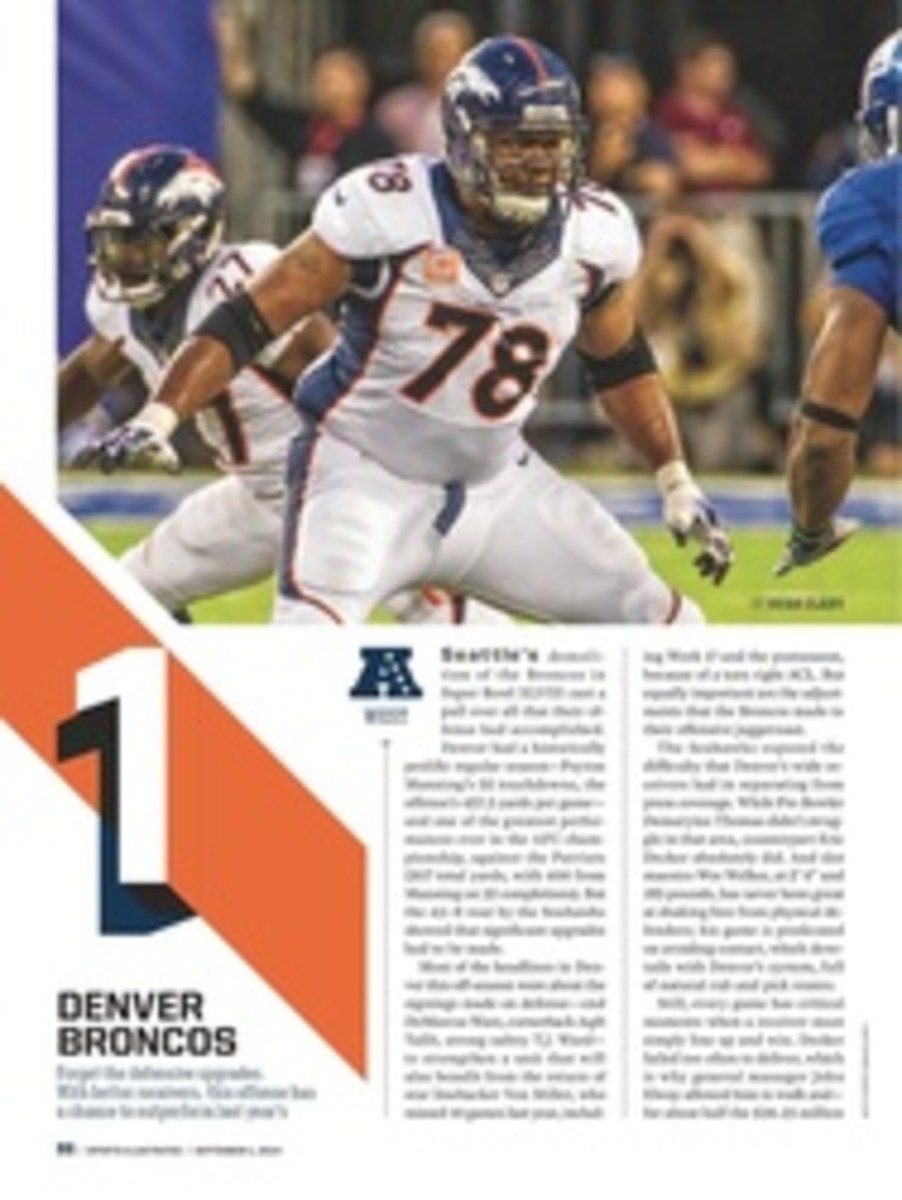
3 CINCINNATI BENGALS
The Bengals of late get at the most fascinating question of the NFL's modern era: Does a franchise need a superstar quarterback to win a Super Bowl?
Russell Wilson, an excellent young playmaker but not yet a superstar, gave one possible answer last year in guiding the Seahawks to a title: Yes, if a team also has a once-in-a-decade defense. (See also: the Bucs, with Brad Johnson; the Ravens, with Trent Dilfer....) Cincinnati's D is good—but not that good. Meanwhile, the Bengals possess a potent offense built around what appears to be an average quarterback. Which gets us back to the Question.
On the one hand, Andy Dalton is the first passer to have led Cincy to three straight playoff appearances, and he's just the fifth in league history to do that in his first three seasons. On the other, Dalton is widely blamed for first-round losses in each of those years.
In the 2011 wild-card round, against the Texans, Dalton threw three interceptions and zero touchdowns. One year later, in the same round against the same team, he completed just 14 of 30 passes for 127 yards and an interception. But neither loss drew critics' ire like his three-turnover stinker last year, in a home wild-card loss to the Chargers.
How much do these defeats fall on Dalton? In that first loss, recall that J.J. Watt made an otherworldly pick-six just before halftime, changing the tenor of the game. In the second meeting none of Dalton's receivers—including the redoubtable A.J. Green, against thick double teams—did him the favor of getting open. And against San Diego, Cincinnati's O-line failed to handle the slanting pressure concepts brilliantly concocted by defensive coordinator John Pagano. Dalton was moved off his spot all afternoon and had no chance of establishing a rhythm.
Perhaps Dalton deserves less of the blame. Or maybe his inability to thrive amid chaos and outside of structure speaks to his ceiling.
The Bengals have all the pieces around Dalton. This line is well-schooled and filled with experienced leaders, like left tackle Andrew Whitworth, alongside a couple of talented-but-inconsistent first-rounders in right guard Kevin Zeitler and right tackle Andre Smith. They'll block for a rushing attack that will carry this offense even more than in the past. Giovani Bernard, a second-rounder in 2013, is one of the most electrifying backs in football, and this year's second-round pick, Jeremy Hill (LSU), appears to be a more dynamic early-down runner than BenJarvus Green-Ellis.
Nonetheless, Cincinnati's playoff fate will inevitably hinge on how new coordinator Hue Jackson (promoted from running backs coach to replace Jay Gruden, now the boss in Washington) manages the passing game—specifically, his lightning-rod signal-caller.
The operative word here: manages. Three playoff losses have accentuated what three regular seasons hinted at in drips and drabs: Dalton has limitations. Because you can't coach raw arm strength, Jackson must help Dalton through play design, just as Gruden did before him. Dalton, who is smart in the pocket, must be an even better anticipation passer—someone who consistently identifies throwing windows before they actually appear. It's now on the 26-year-old QB to develop the awareness, pocket poise and guts to be that when it counts most. And it's on Jackson to create defined reads to help him.
Back to the Question, this much can be agreed upon: If you don't have a superstar quarterback (or a historic D), you must possess at least one playmaking wide receiver. And after Calvin Johnson, Green is the best in the game. Tremendous start-stop acceleration and body control allow the 6'4" 207-pounder to burst off the line of scrimmage and fluidly stem routes upfield, where he then either a) shifts gears and goes deep or b) throttles back underneath, creating separation that can only be combatted with double coverage. Green is sensational at adjusting to poorly thrown balls. The concern is how often he has to do this; he and Dalton still have not developed great chemistry.
Filling out the receiving corps, Marvin Jones is a budding star (when healthy) while Mohamed Sanu is a fine slot resource who can make possession catches outside. And the tight end duo of Tyler Eifert and Jermaine Gresham gives the Bengals pliability out of base personnel. Factor in a dynamic, versatile playmaker like Bernard and Jackson has the flexibility to play up-tempo football.
The idea is for Jackson to develop a scheme and a supporting cast strong enough to make an average quarterback look great. That's this team's best—and only—shot at a deeper playoff run.
2014 SCHEDULE
2013 Record: 11--5
WEEK 1
BAL [AWAY]
ATL [HOME]
TEN [HOME]
BYE
NE [AWAY]
CAR [HOME]
IND [AWAY]
BAL [HOME]
JAX [HOME]
CLE THUR[HOME]
NO [AWAY]
HOU [AWAY]
TB [AWAY]
PIT [HOME]
CLE [AWAY]
DEN MON [HOME]
PIT [AWAY]
WEEK 17
KEY CONCEPT
The play-action bomb
The deep ball is a key component of any offense; it's one the Bengals dialed up frequently under last year's offensive coordinator, Jay Gruden, and one they'll return to often under Gruden's replacement, Hue Jackson. While the play's distance makes it appear difficult, the opposite is actually true. Most play-action bombs are called on first down near midfield, where defenses typically align in predictable base packages and are likely to bring a safety down in the box. The quarterback only has to read his receiver's relation to the deepest safety. If the throw is not there, check down. If it is, a seven-step drop and run fake can take care of the pass rush. In A.J. Green the Bengals have one of the league's most effective deep threats. The only problem: Andy Dalton is not always on point with his ball trajectory and placement. The progress he makes in those departments will be key to creating an attack that matches Cincinnati's explosive personnel.
THE CASE FOR
Defensive coordinator Paul Guenther
After longtime coordinator Mike Zimmer was called upon to take over the Vikings, the Bengals characteristically replaced him from within, promoting Guenther, a linebackers coach who came up through the ranks, starting as a special teams assistant. Guenther, 42, figures to continue what Zimmer started. The Bengals have some of the sharpest 4--3 and nickel zone blitz concepts in football. And thanks to the front office's commitment to drafting athletic D-linemen in the middle rounds each year, there's a bevy of resources along the front four to make those concepts work, even with the exit through free agency of end Michael Johnson, to Tampa. Geno Atkins was far and away the best 4--3 tackle in football before tearing his right ACL last Halloween. When he's fully recovered, rising young end Carlos Dunlap will face more single blocking, and a veteran secondary (which is skilled at disguising coverages) won't have to shoulder too heavy a burden. Guenther has never held this title in the pros, but with his myriad blitz concepts and understanding of multiple positions, he's in a position to succeed.
PHOTO
GARY WIEPERT/AP
QB ANDY DALTON
PHOTO
AL BEHRMAN/AP
NINTEEN PHOTOS

